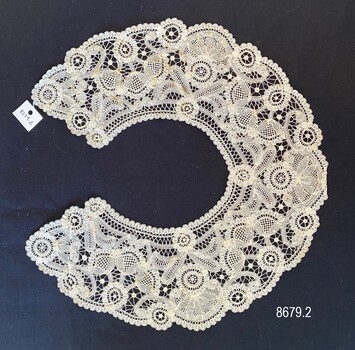Historical information
Lace collars and cuffs were used by women in the late 19th and early 20th century to embellish their clothing. They were able to be detached which made them suitable as a decorative object on clothing that could be easily changed when required. Duchesse lace, was produced in Belgium from about the mid-nineteenth century onwards. In general, it was regarded as a cheaper version of 'true' Brussels lace and is a form of bobbin lace. The lace set was part of a collection belonging to Alice Matilda Barrie. Alice was born on October 17th, 1885 at Willowie, SA, she died on May 10th, 1981 in Adelaide. Alice was the daughter of Thomas and Luisse Mathilde Wood. Thomas was the publican of the Willowie hotel and Alice's brother Frank owned the Willowie store where the lace set may have been purchased. A family photo shows Alice wearing a lace collar in the early 1940’s which confirms her use of similar articles.
Significance
The lace set has significance historically and socially as an example of textile accessories women used to embellish their clothing in the late 19th and early 20th century.
Physical description
A Duchesse lace set comprising three collars, a pair of cuffs and a hanky. Two of the collars are rounded and the third has a rectangular back and falls to points at the front. The lace on the hanky has been handstitched to the fine linen centre shape. In each piece the lace motifs are flower based (petals, stems, leaves) and are joined by thin bars.












